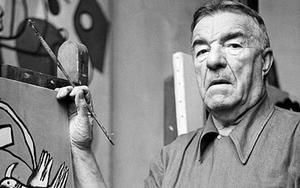Fernand Léger
Fernand Léger (1881–1955) was a pioneering French artist pivotal to the development of modern art in the early 20th century. Born in Argentan, France, Léger initially trained as an architect but soon turned his focus to painting. His artistic journey evolved through various phases, each marked by a distinctive visual language. In the early 1910s, Léger became associated with Cubism, working alongside artists like Pablo Picasso and Georges Braque. However, he diverged from the strict analytical approach of traditional Cubism, infusing his work with a dynamic energy and a focus on the rhythmic interplay of shapes.
Léger's art is characterized by a fascination with the urban and industrial landscape. His paintings often depict bustling city scenes, machinery, and the human form, stylized through his unique lens. Influenced by the rise of technology and the machine age, the artist embraced the visual language of abstraction, employing simplified forms and bold primary colours to convey the dynamicism of modern life.
Léger's iconic "tubism" concept, featuring cylindrical forms and tubular shapes that dominate the compositions; exemplified in masterpieces such as "The City" (1919), that encapsulate his vision of an industrialised, mechanised society. Beyond canvases, he explored diverse media, collaborating in film and book illustration. His versatility, boundary-pushing, and commitment to capturing the zeitgeist make him a visionary in modern art. Today, Fernand Léger is hailed not just for his artistic innovation but also for his lasting impact on the avant-garde movement, leaving an enduring legacy in the evolution of contemporary art.
Featured Artists
- Albers Anni
- Ancart Harold
- Andre Carl
- Avery Milton
- Baldessari John
- Barnes Ernie
- Castellani Enrico
- Clough Prunella
- Crawford Brett
- Dadamaino
- de Tollenaere Saskia
- Dyson Julian
- Elsner Slawomir
- Freud Lucian
- Gadsby Eric
- Gander Ryan
- Guston Philip
- Hartung Hans
- Hayes David
- Held Al
- Hepworth Barbara
- Hill Anthony
- Hitchens Ivon
- Hockney David
- Hutchinson Norman Douglas
- Jenney Neil
- Katz Alex
- Kentridge William
- Knifer Julije
- Kusama Yayoi
- Le Parc Julio
- Leciejewski Edgar
- Léger Fernand
- Levine Chris
- Marchéllo
- Martin Kenneth
- Mavignier Almir da Silva
- Miller Harland
- Mitchell Joan
- Modé João
- Moore Henry
- Morellet François
- Nadelman Elie
- Nara Yoshitomo
- Nesbitt Lowell Blair
- Nicholson Ben
- O'Donoghue Hughie
- Pasmore Victor
- Perry Grayson
- Picasso Pablo
- Pickstone Sarah
- Prehistoric Objects
- Riley Bridget
- Ruscha Ed
- Sedgley Peter
- Serra Richard
- Shrigley David
- Smith Anj
- Smith Richard
- Soto Jesús Rafael
- Soulages Pierre
- Spencer Stanley
- Taller Popular de Serigrafía
- The Connor Brothers
- Vasarely Victor
- Vaughan Keith
- Whiteread Rachel
- Wood Jonas

